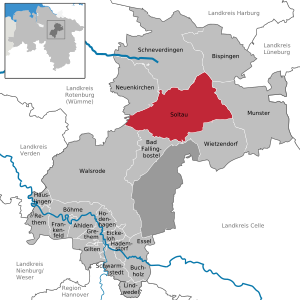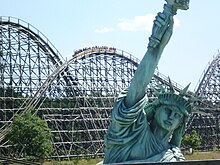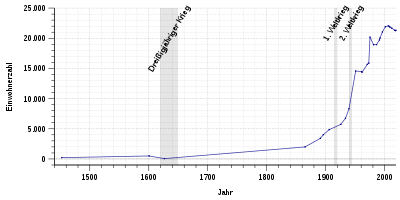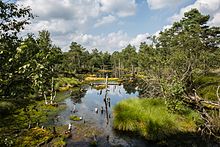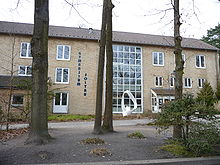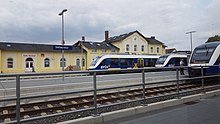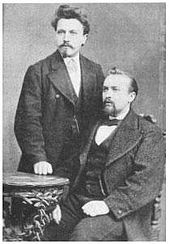Soltau
| coat of arms | Germany map | |
|---|---|---|

|
Coordinates: 52 ° 59 ' N , 9 ° 51' E |
|
| Basic data | ||
| State : | Lower Saxony | |
| County : | Heidekreis | |
| Height : | 57 m above sea level NHN | |
| Area : | 203.25 km 2 | |
| Residents: | 21,268 (Dec. 31, 2019) | |
| Population density : | 105 inhabitants per km 2 | |
| Postal code : | 29614 | |
| Primaries : | 05191, 05190 , 05197 | |
| License plate : | HK | |
| Community key : | 03 3 58 021 | |
| LOCODE : | DE SOU | |
City administration address : |
Poststrasse 12 29614 Soltau |
|
| Website : | ||
| Mayor : | Helge Röbbert ( independent ) | |
| Location of the city of Soltau in the Heidekreis district | ||
Soltau is a medium- sized town in Lower Saxony in the Heidekreis district . The city is centrally located in the Lüneburg Heath and is known nationwide in particular for its tourist attractions such as the Heide Park and the Soltau Therme .
geography
Soltau is located in the Lüneburg Heath on the Böhme and Soltau rivers . In regional planning , the city is designated as a medium-sized center. The distances to the major cities of Bremen in the west, Hamburg in the north and Hanover in the south are each around 65 to 70 kilometers.
City structure
The following former municipalities and today's localities or districts together with the core city form the urban area of Soltau:
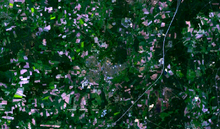
|
Neighboring communities
|
Neuenkirchen , Rotenburg (Wümme) 11 km, 33 km |
Schneverdingen , Hamburg 15 km, 63 km |
Bispingen , Lüneburg 15 km, 48 km |
|
Visselhövede , Verden 17 km; 42 km |

|
Munster , Uelzen 17 km, 48 km |
|
Walsrode 22 km |
Bad Fallingbostel , Hanover 16 km; 69 km |
Bergen , Celle 21 km; 43 km |
climate
With an average annual precipitation of 741 mm, Soltau is just above the Germany-wide average of 700 mm. The average temperature is 8.4 ° C and fluctuates between -0.1 ° C in January and 17.6 ° C in July .
| Soltau | ||||||||||||||||||||||||||||||||||||||||||||||||
|---|---|---|---|---|---|---|---|---|---|---|---|---|---|---|---|---|---|---|---|---|---|---|---|---|---|---|---|---|---|---|---|---|---|---|---|---|---|---|---|---|---|---|---|---|---|---|---|---|
| Climate diagram | ||||||||||||||||||||||||||||||||||||||||||||||||
| ||||||||||||||||||||||||||||||||||||||||||||||||
|
Average monthly temperatures and precipitation for Soltau
Source: wetterkontor.de
|
|||||||||||||||||||||||||||||||||||||||||||||||||||||||||||||||||||||||||||||||||||||||||||||||||||||||||||||||||||||||||||||||||||||||||||||||||||||||||||||||||||||
history
middle Ages
The landscape in the Lüneburg Heath has been inhabited since the beginning of the Neolithic around 4000 years ago, as numerous archaeological finds indicate. Initially there were only individual courtyards in the Soltau area. Probably around 830 the Parish Soltau was founded and the first wooden church Sante Johannis Baptista was built.
Soltau was first mentioned in a document in 936 as "Curtis Salta" (Hof an der Salzaue). King Otto the Great donated the inheritance from the Carolingian era to the Quedlinburg monastery . In a period of almost 600 years the farm “Curtis Salta” became the village “Soltouwe” . It was located in the area between Johanniskirche and Waldmühle . Old names were Salzowe (in the 10th century), Saltowe (1068 and 1197) and Soltowe (1304). The name Soltau was first used in 1791 and originated from the word stems Solt (salt) and -au (river / stream).
The first fortifications at the confluence of the Soltau and Böhme rivers , today's city center, can be traced back to the time of Emperor Frederick I Barbarossa (1152), which were later built. During construction work on the weir of the council mill , palisade structures were discovered that can be dated back to 1241. In 1304 the Soltau bailiwick was sold to the Verden cathedral chapter . Between 1383 and 1388, by order of the duke, the village was relocated to the confluence of the Böhme and Soltau rivers near Hagen and Burg, which today represent the city center, to protect it from robber barons. Subsequently, in the peace treaty of the War of the Lüneburg Succession , it was decided to demolish the castle ; at the same time, Soltau was granted city rights on July 15, 1388 as compensation . In 1400 the guild letter was issued, which entitles to trade. In 1440 another guild letter was specially awarded to blacksmiths , tailors , shoemakers , sheet and cloth makers .
The consequences of the War of Succession were clearly noticeable in Soltau and prevented the young city from growing rapidly, the conditions were miserable and many farms were ruined. In addition, Soltau was far away from the rulership, so that there was hardly any direct support and no feeling of belonging to a rulership could arise. In 1479 Soltau came to the Duchy of Braunschweig-Lüneburg , and an official bailiwick was established. In 1511 the city was completely destroyed by fire.
The last known knight battle ever took place in June 1519 on the Wiehe Holt near Soltau and is known as the Battle of Soltau , which represented the climax of the Hildesheim collegiate feud . According to old traditions, it is only thanks to a ruse by the Soltau citizen Harm Tyding, who faked the advancing Brunswicks that a large Lüneburg army was being stored and led them to take a detour, that the city was not destroyed again.
Modern times
In 1533 the town hall was set up in a former chapel on Marktstrasse. In 1567, another major fire destroyed large parts of the city. The plague raged in 1626 and caused the population to drop dramatically.
In the Thirty Years' War Soltau was completely destroyed one more time. All that remained was a large ruin in the landscape, only a single building from that time has been preserved. The effects of the war were devastating; it took a long time for Soltau to recover from the consequences. The traces of the war and the occupation by Swedish troops , which began in 1632, are still documented today by the "Ellinger Grenzstein".
Soltau became a garrison town for the first time in 1712, and the first cloth factory was built in that year. Napoleonic troops occupied the city in 1803 and made it a French border town to the Kingdom of Westphalia in 1810 . Soltau belonged to the canton of Harburg in the department of the Nieder-Elbe . In 1813, Lützow hunters and Cossacks ended the ten-year occupation (" French period "). In 1826 today's old town hall was built on Poststrasse.
From 1873 the first railway line , which connected Bremen and Berlin as the American line , ran through Soltau, later the Heidebahn lines followed , which had connected Hamburg and Hanover since 1901 and in 1912 the lines of the Osthannoversche Eisenbahnen AG to Celle and Lüneburg . In 1885 Soltau was made a district town .
In 1888 the building of the ev.-luth. Zionskirche ( SELK ) in the Neutetendorf district, today Soltau, completed and consecrated. On Christmas Eve 1906 a fire destroyed the St. John's Church (first mentioned in 1464); this was rebuilt and still stands today. In 1911 the Luther Church was consecrated as the second Protestant church in the regional church of Hanover , followed by the Catholic St. Mary's Church in 1915 . A royal officers' riding school was established in 1913.
The Soltau camp , the largest German prisoner- of- war camp of the First World War , was established in 1914. In 1919 a 2,000 cubic meter gas tank was built. Until its demolition in 1971, it was considered a symbol of Soltau.
From 1934 the Wolterdingen camp housed several units of the Wehrmacht and after the end of World War II until around 1960 refugees and forced laborers returning home . At times the front ran through Soltau. On April 17, 1945 British troops occupied Soltau after heavy artillery fire. Wehrmacht troops had previously tried bitterly to stop their advance on the Aller. The attacks hit many times more civilians than soldiers; the city was partially destroyed in April 1945.
In Soltau, shortly before the liberation of the city by Allied troops in April 1945, a crime against escaped concentration camp prisoners occurred . They had been able to free themselves from a bombed freight train in Soltau. In the following days, over 100 of them were hunted and captured by members of the Wehrmacht, SS , the local Hitler Youth and some Soltau citizens and then killed or shot on the spot or at assembly points in the city. At risk of death, a few citizens helped refugees with food and clothing. Trials against those involved in the post-war period ended in acquittals for lack of evidence. To commemorate these people murdered in Soltau, a memorial made up of eight model steles from the Berlin Holocaust memorial was erected near the killing site in 2007 .
present
The rebuilding of the city and the provision of numerous new building areas were a priority in the 1950s and 1960s and led to a building boom in the city.
On March 1, 1974, the communities of Ahlften, Brock, Deimern, Dittmern, Harber, Hötzingen, Leitzingen, Marbostel near Soltau, Meinern, Mittelstendorf, Moide, Oeningen, Tetendorf, Wiedingen, Wolterdingen and Woltem were incorporated. In 1977 the districts of Soltau and Fallingbostel were merged to form the district of Soltau-Fallingbostel ; Soltau lost the district seat.
In the 1980s, an extensive urban renewal plan was developed and implemented. The conversion of Marktstrasse into a pedestrian zone and the redesign of the Hagens were just as much a part of it as the construction of the New Town Hall .
The Heide-Park was opened in 1978, today it is the largest amusement park in Northern Germany, in which among other things in 2001 " Colossos ", the then largest and steepest wooden roller coaster in the world, and in 2003 " Scream ", the highest free fall tower in the World. Further tourist attractions followed with the toy museum in 1984 and the Soltau thermal baths in 1990.
After the withdrawal of the British armed forces in 1993, the British barracks were the first in Germany to be converted into private use; today, among other things, there is the Alte Reithalle event center, which opened in 2003 .
In March 2007 a concept for the modernization of the inner city was presented. The “ Schaper-Markt ”, built in the 1970s and unused since 2004 , a pedestrian bridge (popularly “Fenner-Kringel”), a parking garage and the stage in Hagen were demolished in 2008, leaving a new building with a total sales area of around 4000 m² could arise. The new business building was opened in March 2009.
At the end of August 2012, after many years of discussion and planning, the Designer Outlet Soltau opened in Soltau-Harber on a total area of 13,500 m². In 2015, the felt world in the city center complemented the tourist attractions of Soltau.
Population development
The oldest list of citizens in the city register from 1452 counted 42 households in Soltau, which, under the circumstances at that time, corresponded to a good 200 inhabitants. Around 1600 there were around 100 households in Soltau, which corresponded to around 500 inhabitants who lived in around 70 houses. The plague raged in 1626 and caused the population to drop dramatically. The population then rose slowly at first, and more rapidly from 1940 onwards. The large increase in 1974 can be explained by a regional reform and the associated incorporation of 16 surrounding villages. After a brief slump in numbers, the number of inhabitants continued to grow in the 1990s and in 2005 reached the previous high of 22,044. According to internal censuses, the city sometimes gives larger numbers, e.g. B. for the year 2001 23,508 residents, this can mostly be explained by counting second homes . Since then the population has decreased slightly every year. According to a study by the Bertelsmann Foundation, this trend should continue over the next few years . For the year 2025, the study predicts a population of 21,614.
|
|
religion
The majority of denominational residents belong to the Evangelical Lutheran Church. Soltau is the seat of the superintendent of the church district Soltau and from 1936 to 1959 was the seat of the state superintendent of the district of Celle. In addition, from 2013 to 2018 Soltau was also the seat of the superintendent of the Lower Saxony-West church district of the SELK .
There is also a Roman Catholic congregation with a parish church , a New Apostolic congregation, as well as Jehovah's Witnesses and members of Islam . The latter set up the first mosque in the district in Soltau in 2010 .
politics
City council
The city council consists of 34 councilors. Since the local elections in 2016, the seats have been distributed among the individual parties or lists as follows:
| Parties and constituencies | 2016 | 2011 | 2006 | 2001 | 1996 | 1991 | 1986 | ||||||||
|---|---|---|---|---|---|---|---|---|---|---|---|---|---|---|---|
| be right | Seats | be right | Seats | be right | Seats | be right | Seats | be right | Seats | be right | Seats | be right | Seats | ||
| CDU | Christian Democratic Union of Germany | 36.32 | 12 | 37.85 | 13 | 35.03 | 12 | 43.12 | 15th | 37.59 | 14th | 32.72 | 11 | 42.94 | 15th |
| SPD | Social Democratic Party of Germany | 26.04 | 9 | 28.12 | 10 | 31.39 | 11 | 32.92 | 12 | 28.89 | 10 | 27.81 | 9 | 30.71 | 11 |
| BU | Citizens Union | 10.18 | 4th | 13.21 | 5 | 19.45 | 6th | 13.53 | 4th | 18.92 | 7th | 17.55 | 6th | 16.06 | 5 |
| Green | Alliance 90 / The Greens | 9.14 | 3 | 12.09 | 4th | 5.14 | 2 | 4.88 | 1 | 10.52 | 3 | 17.58 | 6th | 6.80 | 2 |
| FDP | Free Democratic Party | 2.76 | 1 | 1.42 | 0 | 6.40 | 2 | 5.54 | 2 | 4.09 | 0 | 4.34 | 1 | 2.05 | 0 |
| left | The left | 1.28 | 0 | 2.69 | 1 | 2.59 | 1 | - | - | - | - | - | - | - | - |
| dps | dps - Independent Council Group | 5.54 | 2 | 4.34 | 1 | - | - | - | - | - | - | - | - | - | - |
| AfD | Alternative for Germany | 8.73 | 3 | - | - | - | - | - | - | - | - | - | - | - | - |
| total | 34 | 34 | 34 | 34 | 34 | 33 | 33 | ||||||||
mayor

From about 1410 the administration of the city of Soltau consisted of a mayor (proconsules) and three other council members (consules). This composition probably existed until the 19th century.
From 1946 to 2001 the city was led by a dual leadership of honorary mayor and city director as head of administration. Werner Peterssen (1946–1951), Paul Müller (1951–1956), Friedrich Peters (1957–1971) and Jürgen Fenner (1971–2001) worked as city directors . In 2001 the two posts were combined in the office of full-time mayor.
The directly elected mayor of the city of Soltau is currently Helge Röbbert (independent).
List of former mayors
- 1461-1474: Johan Meyer
- 1474-1476: Harmen Barnebroke
- 1476–1477: Hinrich Lakenmacher
- 1478-1481: Johan Meyer
- 1481–1485: Hinrich Lakenmacher
- 1485–1500: Diderik to Moide
- 1500-1536: Hans Smet
- 1536-1545: Henning Smet
- 1545: Hans Pentzhorn
- 1545-1549: Cordt Meyer
- 1549–1559: Peter Brümmerhoff
- 1559–1560: Jürgen Wolters
- 1560–1567: Ludtke Wischhof
- 1567: Otto von Kroge
- 1567–1568: Jürgen Wolters
- 1568–1570: Otto von Kroge
- 1570-1575: Ripke Pentzhorn
- 1575: Hinrich van Swolle
- 1575-1580: Hans Meyer
- 1580–1581: Otto von Kroge
- 1581–1589: Barthold von Alven
- 1589–1593: Hinrich Swulle
- 1593–1597: Hans Meyer
- 1597–1599: Diderik Schütte
- 1599-1604: Hans Meyer
- 1604–1609: Diderik Schütte
- 1609–1619: Henning Drewes
- 1619–1655: Hans Schütte
- 1655–1690: Albert Helberg
- 1690–1693: Hans von Minden
- 1693–1710: Johann Schütte
- 1710–1745: Heinrich Springhorn
- 1745–1750: Joachim Röders
- 1750–1768: Diedrich van Alven
- 1768–1784: Rudolf Thieling
- 1784–1802: Joachim Springhorn
- 1802–1815: Johann Wilhelm Bornemann
- 1815–1824: Carl Dietrich Dransfeld
- 1824–1825: Johann Wilhelm Bornemann
- 1825–1832: Johann Christian Röders
- 1832–1848: Carl Breiding
- 1848–1853: Eduard Weinlig
- 1853–1857: Daniel Bornemann
- 1857–1861: Andreas Springhorn
- 1861–1869: Andreas Ernst Albers
- 1869–1871: Daniel Bornemann
- 1872–1878: Johann Ferdinand Meyer
- 1878–1884: Carl Hümme
- 1884–1887: Friedrich Freudenthal
- 1887–1896: Alfred Wilhelm Eduard Carl Lüning
- 1896–1904: Viktor Pfeiffer
- 1904–1909: Rudolf Picker
- 1909–1913: Fritz Scheel
- 1913–1945: Willy Klapproth
- 1945–1946: Werner Peterssen
- 1946–1948: Hermann Wilkens
- 1948–1972: Hartwig Lindloff
- 1972–1974: Wolfgang Buhr
- 1974–1976: Walter Rothardt
- 1976–1981: Jochen Rothardt
- 1981–1991: Emil Werner
- 1991–1996: Wolfgang Bargmann
- 1996–2006: Christa Erden
- 2006–2014: Wilhelm Ruhkopf
- Since 2014: Helge Röbbert
badges and flags
| Coats of arms and flags | |

|

|

|
|
Blazon : "In gold, a growing, black-grooved, red city gate with exposed gate sides and a framed open round portal under the battlements, three red round towers growing out of it, topped with a blue lion above, the middle one slightly raised, in all below the one with black crosses - the middle one with a tower ball and cross - blue conical roofs and a silver-framed black arched window. "
The city's website also shows the coat of arms listed here, which should be emblazoned as follows: gold, three red towers with blue pointed roofs on a red, open city gate and topped with a blue lion above. This composition (the unmotivated upper half lion with a tail) would be somewhat unusual, so that the question arises as to whether a heraldic mishap has not occurred.
The lion is the Lüneburg lion.
Originally the lion was on the gate, but this was changed at the beginning of the 19th century. The oldest coats of arms date from around 1400 and at that time only showed the blue lion.
Description of the flag: “The colors of the city are yellow-blue. The flag is yellow and blue divided with the coat of arms in the middle. It is also shown without a coat of arms. "
Town twinning
-
 Coldwater , USA (since 1971)
Coldwater , USA (since 1971) -
 Laon , France (since 1972)
Laon , France (since 1972) -
 Soldin / Myślibórz , Poland (since 1997)
Soldin / Myślibórz , Poland (since 1997) -
 Osterburg , Germany , friendship between cities (since 1991)
Osterburg , Germany , friendship between cities (since 1991) -
 Grünberg in Silesia / Zielona Góra , Poland , city friendship (since 1997)
Grünberg in Silesia / Zielona Góra , Poland , city friendship (since 1997)
elections
In the elections for the Lower Saxony Parliament Soltau forms with the cities of Munster and Schneverdingen and the communities Bispingen and Neuenkirchen the constituency Soltau .
In the case of federal elections , Soltau has to demonstrate membership of various federal electoral districts:
| Bundestag elections | Constituency number | designation |
|---|---|---|
| 1949 , 1953 , 1957 , 1961 | 36 | Harburg - Soltau |
| 1965 , 1969 , 1972 , 1976 | 30th | Soltau - Harburg |
| 1980 , 1983 | 30th | Soltau-Fallingbostel - Rotenburg |
| 1987 , 1990 , 1994 , 1998 | 30th | Soltau-Fallingbostel - Rotenburg II |
| 2002 , 2005 | 36 | Soltau-Fallingbostel - Winsen L. |
| 2009 | 36 | Rotenburg I - Soltau-Fallingbostel |
| 2013 , 2017 | 35 | Rotenburg I - Heidekreis |
Culture and sights
Theaters and museums
Opposite the old town hall , which is also worth seeing, in the center of the city are the building of the Soltau Game Museum with 600 m² of exhibition space and the Soltau Museum . This traces the history of Soltau up to 200,000 years into the past. In May 2015 the Museum Felto - Filzwelt Soltau , an education and experience center on the subject of felt, opened in the city center . The history of local salt production is presented in the Soltau Salt Museum.
Buildings
A number of churches were built in Soltau, such as the St. John's Church , which was first mentioned in a document in 1464. The Luther Church was built in 1911 as the second Protestant church in Soltau after the St. John's Church burned down in 1906 and was rebuilt in a smaller form.
Other sacred buildings are the Catholic St. Mary's Church , built in 1915, the Heilig-Geist-Kirche in Wolterdingen as an old Gothic heather church from 1245, the Heidenhof chapel built in 1349 and the Zion Church of the SELK from 1888.
Additional properties are the Hagen with drawbridge and the so-called popularly Marriage Fountain, 1978 by Karlheinz Goedtke was built, as well as the forest mill and the Ratsmühle .
Architectural monuments
See the list of architectural monuments in Soltau
Green spaces and recreation
The Breidings Garten landscape park , which is a listed building , is close to the city center . It was laid out around 1850 based on the English model and is 11 hectares in size. In addition to an Italian-style villa, there is also an artificial castle ruin, an old farm and fish and ornamental ponds on the site. It is currently privately owned but can be viewed.
The Böhmepark and Röders' Park on Halifax are also located in the urban area. Local recreation areas are the Wacholderpark, a heather area with a sheepfold, the Ahlftener Flatt , a lake from the last ice age that is often used for ice skating in winter, and the Kuhbachforst. Around Soltau there are parts of the 14,500 hectares of the Soltau monastery forest, which is looked after by the Soltau monastery forest office.
The leisure park Heide-Park Soltau is known far beyond the region . Other leisure activities can be found in the Soltau-Therme , the Designer Outlet Soltau and the Hof Loh golf course .
The nature reserves Böhmetal near Huckenrieth , Ehbläcksmoor and the Black Moor near Dannhorn are located in Soltau districts .
The Grundlose Kuhle is a special kind of natural monument . A circular earth funnel about 40 m in diameter, with an almost circular small pond about 5 m deep and 20 m in diameter. The water level is 1 ½ m above the nearby Böhme. Although it has neither an inlet nor an outlet, it hardly changes. The sinkhole was caused by salt leaching in the ground and represents a geological karst form of national importance.
Soltau maintains two cemeteries, the city cemetery and the forest cemetery. In addition, the remains of the Jewish cemetery , where burials were held from 1721 to 1926, have been preserved.
Regular events
The Soltau cultural association and the cultural initiative regularly organize readings and concerts in the Bohemian city. Since 2008, the culture week Zwischenpiel - Das Zelt has been held annually, in which readings, concerts, cabaret and theater performances are held in a circus tent. There are also the “Soltau Talks” initiatives and the Soltau artist apartment, which has been welcoming writers, painters and musicians since 1995. The Waldmühle Library takes part in the summer reading club project of the NRW Culture Secretariat .
- Spring market (last weekend in April)
- Bread and Ham Day (May 1st)
- City festival (every 2 years, first weekend in June)
- Knight, Pot and Lid (Medieval Festival)
- Schützenfest (first full week of July)
- Interlude - The Tent (Culture Days)
- Summer evening in Halifax with Luminous Fountains (every two years, last Saturday in July)
- Festival of Lights (first Saturday in September)
- Mauritius Festival and Craft Market (October 2nd and 3rd)
- Farmer's Market (fourth weekend in October)
- Christmas market (first weekend in Advent)
Sports
The oldest sports club in Soltau is MTV Soltau , which was founded in 1864. Today it comprises 16 different branches, of which the gymnastics and soccer departments are the largest. The handball department of MTV achieved participation in the DHB Cup and promotion to the fourth-class league in 2010 .
The second oldest sports club in Soltau is SV Soltau , which was founded in 1912. Here, too, the main focus is on football; there are also four other branches. In 2002, a third football club was founded in the city, SG Inter Soltau , but it was dissolved again in 2008.
The oldest tennis club is the TC Blau-Weiß Soltau. Founded in 1952, the first tennis court in Soltau was created. There is also a second tennis club, the TVC Soltau. In 1993 a table tennis club followed with the TTC 93 Soltau .
Since 1987 Pool -Sports in Soltau in Pool Billiards Sports Club Triangle played. The club plays in the highest Lower Saxony league and took part in several German championships.
In addition to the Schützengilde Soltau Stadt und Land, which began with the first rifle festivals in the 15th century and has held a rifle festival almost every year since 1741, there are also around 20 smaller clubs in around 30 different sports.
The sports facilities include an all-weather pool with a convertible roof, six sports fields, eight sports halls, a riding hall , a golf course , three tennis facilities , four bowling alleys , a squash facility, an inline skater facility , a pond for the sports fishing club and the 2000 m² indoor pool. Heidewitzka playground .
Soltau the playoffs to that found from 1960 to 1971 four times German Championship in water polo instead. The German championships in vaulting in 1984, 1987, 1994 and 1997 were also held in the city. In addition, the Heide-Park has been the venue for the canoe whitewater sprint as part of the Germany Cup every year since 2004 . Heide-Park took place in April 2003, the WWCL -Finals and in September 2006 the German qualification of the World Cyber Games 2006 in e-sports , and between 1997 and 2003, the annual world championship in pole-sitting instead.
Economy and Infrastructure
Companies
Industry
Numerous companies from industry and trade have settled in Soltau. In metal processing and mechanical engineering in particular, there are Röders-Tec (HSC milling machines, blow molding, tin), GARöders (pressure / injection molding, toolmaking), ISI Industrie Service International (industrial assembly ), Röhrs AG (plant construction, industrial assembly , Kraftwerksservices), Saxlund International (conveyors, pumps), Nortec (mechanical engineering) and Colt International (technical building protection) some companies. In addition, Harry-Brot (baked goods) and HST Pack Service (tea bag packaging) are active in the food sector, and Gebr. Röders AG (felt) is active in the textile sector.
trade
In addition to the shops in the city center, there are shopping opportunities in Soltau in the specialist market center opened in 1998 in the Alm business park and in over 60 shops in the Designer Outlet Soltau in the Harber district, which opened in 2012 .
The headquarters of Hagebau (purchasing cooperation in the building materials, wood and tile trade) and JAWOLL ( special items market ) and a distribution center for Deichmann (shoes) are located in Soltau . The ZEUS system center for DIY stores is headquartered in the city, while the cattle and meat dealer Raiffeisen Viehvermarktung Zentralheide and the SLC Container Terminal with 250,000 containers for the Port of Hamburg are also located in Soltau. From 1923 to the mid-1990s, the Edeka Group had its headquarters in Soltau, but it was relocated to Minden .
Banks
Soltau is the headquarters of the Kreissparkasse Soltau and was the seat of the Volksbank Lüneburger Heide until 2008 . After this merged with Volksbank Lüneburg, the main office moved to Lüneburg . There is also a branch of Deutsche Bank and Postbank .
media
As a daily newspaper, the Böhme-Zeitung has been published since 1864 with an IVW circulation of 11,298 copies (2nd quarter 2011) . In addition, the Wednesday advertising paper appears weekly with a circulation of 29,000 copies and the Heide-Kurier twice a week with a circulation of 44,000 copies.
Public facilities
Soltau is home to the Soltau District Court , a tax office , a health office and a customs office . In addition, a branch of the Federal Employment Agency and a branch of the Federal Agency for Real Estate, including the North Regional Office of the Federal Claims Authority (SRB), have been set up in the Böhmestadt . Furthermore, a monastery forest office of the monastery chamber Hanover and a church district office are located in the city.
Soltau is one of two locations of the Heidekreis-Klinikum . In addition, the existing rehabilitation -Zentrum Soltau, a clinic of MediClin AG and an outpatient rehab center.
There are three day-care centers , three kindergartens and two children's play groups. In addition to the “Haus Refuge Foundation” nursing home, there are several care services and a diaconal work . In addition to the educational institutions, Lebenshilfe Soltau also operates a dormitory and a workshop for the disabled. In addition, there is the Soltauer Tafel , a women's shelter, a mothers center, a youth leisure meeting place and a branch of the Lobetalarbeit eV Celle. The Teestube Soltau eV offers a meeting point for addicts.
education
Soltau has three primary schools , a grammar school with around 900 pupils and a high school each (formerly a secondary school and a secondary school) and a special school .
In addition, Lebenshilfe Soltau maintains a day-care center, a language therapy kindergarten, a curative educational kindergarten and a crèche for early support.
As a bundle school, BBS Soltau brings together many different school types under one roof. For example, a technical college for economics, technical colleges for technology and business, and numerous vocational schools in the fields of business , IT , technology , housekeeping , care assistance , cosmetics , gastronomy , agricultural science , construction , wood , metal or hairdressing technology . It is attended by around 2,400 students.
The Adult Education Center Heidekreis, based in Soltau and Walsrode , currently offers around 930 courses.
The Waldmühle library is the largest in the district, and the Heidekreis music school has its headquarters in Soltau.
traffic
Rail transport
Soltau station, which is still called Soltau (Han) by Deutsche Bahn because it was in the former state of Hanover , is located on the " Amerikalinie " ( KBS 116) from Bremen to Uelzen and on the " Heidebahn " (KBS 123) from Buchholz (Nordheide) to Bennemühlen (- Hanover ). At the weekend and on public holidays there is also a direct connection to Hamburg-Harburg with the Heidebahn . There are also two other stops (“Soltau Nord” and “Wolterdingen”) on the Heidebahn. The private railway company Erixx , as the operator of the two railway lines, has been based in Soltau since 2011.
Soltau also has a freight yard (" Soltau Süd ") in the OHE network . From there there are freight connections to Celle ( Celle – Soltau railway ) , Uelzen ( Uelzen – Langwedel railway ) and Lüneburg ( Lüneburg – Soltau railway ) . In the past, regular passenger traffic was also carried out on these routes. The "Arbeitsgemeinschaft Verkehrsfreunde Lüneburg e. V. ”still offers individual passenger trips to Celle and Lüneburg on these routes with the“ Heide Express ”. In summer you can also take the “anteater”, a historic “Wismar” railcar from 1937, from Soltau via Bispingen to Döhle and back again.
The previously existing Soltau – Neuenkirchen railway line has since been dismantled. Between 1998 and 2001 there was a Roadrailer -Pendelverkehr of Soltau-Harber to Verona in Italy , where several times a week for the former residents of Soltau company 'alli Frischdienst' was driven. The “Harber” stop is now only used as an alternative connection point.
Street
Soltau is connected to the A 7 (part of the European route E 45 ) via the two motorway exits Soltau-Süd and Soltau-Ost . Further connections exist via the federal highways 3 , 71 and 209 and state road 163.
In addition to the regular regional bus service of the Verkehrsgemeinschaft Heidekreis , which connects Soltau with the surrounding towns and villages, a free 'adventure bus ' runs through the Lüneburg Heath between July and October , which connects the numerous tourist attractions in the region. The two lines of the 'adventure bus' have several stops in Soltau and at Heide-Park. In summer there are also direct bus connections to Heide-Park from Hamburg , Hanover , Lüneburg and Celle .
The long-distance bus provider Flixbus has three stops in Soltau on offer. Line 005 (Hamburg-Hanover-Hessisch Oldendorf) stops at Heide-Park and the Designer Outlet. Line 164 (from Hamburg via Celle / Braunschweig / Magdeburg to Berlin or Wolfenbüttel) has a stop at the Soltau-Süd motorway exit in the timetable. In the past, buses from ADAC Postbus (route Stuttgart - Frankfurt - Hanover - Hamburg - Kiel ) and Berlin Linien Bus also stopped in the city.
Bicycle traffic
In Soltau, the long -distance cycle routes RFW 4 ( Leine-Heide-Radweg ) and RFW 15 (Heide-Radweg) of the Lower Saxony long-distance cycle route network intersect . In 2003 a bicycle traffic concept was developed and implemented, for example bicycle boxes were built at the train station and the cycle path network expanded. In Soltau there are four bed + bike businesses that have been recognized by the ADFC as being particularly bike -friendly.
Personalities
sons and daughters of the town
- August Wöhler (1819–1914), engineer
- Lüder Arenhold (1854–1915), marine painter and captain
- Adolph Goldberg (1860–1938), doctor and Nazi victim
- Gustav Rabeler (1900–1957), politician (SRP), MdL
- Walter Möhlmann (1912–1977), politician (CDU), MdL
- Karl-Heinz Narjes (1924–2015), politician (CDU), Member of the Bundestag
- Wolfgang Bargmann (1926–2020), Mayor of Soltau
- Helmut Amtenbrink (1929–2016), head of the Wolfsburg Volkswagen plant from 1972 to 1988
- Rolf Funck (1930–2015), economist
- Gustav Isernhagen (* 1937), politician (CDU), MdL
- Friedrich Kuhlmann (* 1939), agricultural economist
- Friedemann Schulz von Thun (* 1944), communication scientist
- Ulrike Neumann (* 1945), politician (SPD), MdL
- Fred Tödter (stage name: Tetsche ) (* 1946), cartoonist, humorist and book author
- Frank Hornung (1948–2019), actor and painter
- Dieter Möhrmann (* 1948), politician (SPD), MdL
- Dietmar Hexel (* 1949), politician (SPD), trade unionist
- Klaus Arp (1950–2016), composer, conductor and music teacher
- Klaus Lage (* 1950), singer
- Erich von Hofe (* 1956), politician (Greens), MdL
- Klaus Klang (* 1956), politician (CDU), State Secretary
- Stefan Dorra (* 1958), game designer
- Hans-Werner Wiermann (* 1958), major general in the Bundeswehr
- Matthias Böttcher (* 1959), politician (Greens), MdL
- Andrea Schröder-Ehlers (* 1961), politician (SPD), MdL
- Benedikt Zimmer (* 1961), General in the Bundeswehr
- Ulrike Landfester (* 1962), cultural scientist
- Michael van den Nieuwendijk (artist name: Mijk van Dijk ) (* 1963), DJ, music producer
- Thomas Ostermeier (* 1968), director
- Christian Benbennek (* 1972), football coach
- Chrissy Schulz (* 1972), actress
- Sofie Cramer (* 1974), writer
- Maximilian C. Jehuda Ewert (* 1974), composer
- Marcus Wedau (* 1975), soccer player
- Matthias Marquardt (* 1977), doctor and non-fiction author
- Lars Klingbeil (* 1978), politician (SPD), Member of the Bundestag and SPD General Secretary
- Philip Richert (* 1978), actor
- Klaas Dijkhoff (* 1981), Dutch politician (VVD)
- Marleen Lohse (* 1984), actress
- Marcel Gebers (* 1986), football player
- Philipp Eggersglüß (* 1995), soccer player
- Stefanie Antonia Sanders (* 1998), soccer player
Personalities who have worked locally
- Georg Wilhelm Friedrich Beneken (1765–1824), preacher and publisher, pastor adjunct in Soltau 1795
- Friedrich Freudenthal (1849–1929), writer, mayor of Soltau from 1884 to 1887
- Wilhelm Sagebiel (1855–1940), sculptor, built the altar and pulpit for Luther Church
- Fritz Wildung (1872–1954), politician (SPD) and sports functionary, apprenticeship in Soltau
- Eduard Salfeld (1878–1957), pastor and local researcher, lived and died in Soltau
- Frido Witte (1881–1965), painter, lived and died in Soltau
- Friedrich Fischer-Friesenhausen (1886–1960), poet and writer, lived and died in Soltau
- Wilfried Wolters (1891–1969), theologian, pastor in Soltau, state superintendent of the district of Celle
- Karl Drewke (1895–1960), politician (SPD), grocer in Soltau
- Erich Colberg (1901–1966), pioneer of school play, teacher in Harber
- Ludwig Stubbendorff (1906–1941), rider and Olympic champion, served for a long time in the Soltau riding school
- Ewald Hillermann (1906–2003), writer, worked and died in Soltau
- Herbert Kappler (1907–1978), Nazi officer, fled to and died in Soltau
- Hermann A. Eplée (1908–1973), politician (CDU), Member of the Bundestag, councilor in Soltau from 1947 to 1951
- Hans-Heinz Schütt (1908-?), SS squad leader, city councilor in Soltau
- Eberhard von Breitenbuch (1910–1980), resistance fighter, forester in Soltau
- Willi Eggers (1911–1979), writer, teacher in Soltau
- Joachim Grauenhorst (1917–1998), journalist and painter, headed the Böhme newspaper
- Helga Köhler (1925–2014), show jumper, did military service in Soltau
- Heinrich Kröger (* 1932), pastor and author, pastor in Soltau 1959–1994
- Kurt Palis (* 1937), politician (SPD), Member of the Bundestag, councilor in Soltau 1991–1993
- Sigrid Drewke (* 1937), cook, landlady of the Schützenstuben in Soltau 1961–2016
- Heinz-Günter Bargfrede (* 1942), politician (CDU), Member of the Bundestag, post office clerk in Soltau
- Wolfgang Engels (* 1943), GDR refugee, teacher in Soltau
- Hans-Jürgen Tiemann (* approx. 1950), entrepreneur and racing driver, opened Heide-Park Soltau in 1978
- Pablo Ardouin (* 1951), Chilean musician, lives in Soltau
- Eckhard Gorka (* 1955), state superintendent, superintendent in Soltau 1993–2000
- Karl-Hinrich Manzke (* 1958), regional bishop, pastor in Soltau 1988–1995
- Helmut von Finck (* 1959), owner of the stud, operator of the Wiedingen stud
- Frank Klingebiel (* 1964), politician (CDU), worked at the Federal Property Office in Soltau
Honorary citizen
The honorary citizenship is awarded to people who have made special contributions to the community. Honorary citizenship expires with the death of the person concerned. Soltau currently has no living honorary citizen.
- Eduard Röders, manufacturer, awarded on November 3, 1912
- Wilhelm Röders, awarded on August 29, 1937
- Otto Telschow , National Socialist, awarded on August 29, 1937, revoked on February 13, 2014
- Otto Röders, factory owner, awarded in 1961
- August Röders, manufacturer, awarded in 1963
- Hartwig Lindloff, Mayor, awarded in 1977
- Friedrich Einhoff , painter, awarded in 1988
- Wilhelm Wortmann , urban developer, awarded in 1993
literature
- Wolfgang Bargmann : The Soltau settlement in Lower Saxony history. Volume I: From the Germanic Settlement to the Thirty Years War. 2003, ISBN 3-933802-09-1 . (Summary, ris.stadt-soltau.de ( Memento from May 4, 2015 in the Internet Archive ))
- Wolfgang Bargmann: The city of Soltau in the history of Lower Saxony. Volume II: From the Thirty Years War to the end of the First World War 1620 to 1919. 2005, ISBN 3-933802-14-8 .
- Wolfgang Bargmann: The city of Soltau in the history of Lower Saxony. Volume III: From the end of the First World War in 1918 to the beginning of the second phase of urban renewal in early 2009. 2009, ISBN 978-3-933802-19-4 .
- Wilhelm Schaeffer: History of the city of Soltau. City administration of Soltau, Soltau 1937.
Web links
Individual evidence
- ↑ State Office for Statistics Lower Saxony, LSN-Online regional database, Table 12411: Update of the population, as of December 31, 2019 ( help ).
- ^ Main statute of the city of Soltau. (PDF; 17 kB) City of Soltau, December 9, 2011, accessed on March 21, 2014 .
- ↑ Summary from Wolfgang Bargmann: The Soltau settlement in Lower Saxony history. Volume I: From the Germanic Settlement to the Thirty Years War. ( Memento from July 19, 2011 in the Internet Archive )
- ^ Jürgen Udolph (research): The "place name researcher". (No longer available online.) In: Internet site NDR 1 Lower Saxony . Archived from the original on December 19, 2016 ; accessed on August 5, 2019 .
- ↑ Historical wood from the time of Emperor Barbarossa emerged. January 7, 2019, accessed May 25, 2019 .
- ↑ Information about the Battle of Soltau and Harm Tyding ( Memento from September 24, 2015 in the Internet Archive ) (PDF; 3.7 MB).
- ↑ Bruno Nitsche, Hans-Heinrich Wolfes: The end of the Second World War in Jesteburg. (PDF, 1.0 MB). In: Hans-Heinrich Wolfes: On the 60th anniversary of the end of the war in Jesteburg and the surrounding area. Jesteburg working group for home care e. V., 2005, p. 6.
- ^ Federal Statistical Office (ed.): Historical municipality directory for the Federal Republic of Germany. Name, border and key number changes in municipalities, counties and administrative districts from May 27, 1970 to December 31, 1982 . W. Kohlhammer, Stuttgart / Mainz 1983, ISBN 3-17-003263-1 , p. 236 .
- ^ Population forecast by the Bertelsmann Stiftung Wegweiser Kommune ( Memento from April 29, 2014 in the Internet Archive ).
- ↑ Soltau.de .
- ^ Result of the 2016 council election on wahlen.soltau.de
- ^ Result of the 2011 council election on wahlen.soltau.de
- ^ Result of the 2006 council election on wahlen.soltau.de
- ^ Result of the council election 2001 on wahlen.soltau.de
- ↑ Results of the 1996 council election on soltau.de
- ↑ Allocation of seats in the 1996 council election in Heide-Kurier of September 12, 2001, p. 4.
- ↑ a b Results of the council elections in 1991 and 1986 on soltau.de
- ↑ Soltau City Archives # 485B, # 486B and # 809B
- ↑ Explanations of the Soltau coat of arms on www.ngw.nl (English)
- ↑ Info on the Grundlose Kuhle near Soltau ( Memento from December 22nd, 2015 in the Internet Archive )
- ↑ Editor: The Erixx will soon drive through to Harburg - Heidekreis. Accessed December 30, 2018 .
- ↑ Map of Lower Saxony's long-distance cycle path network (PDF; 651 kB)

